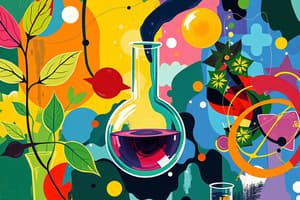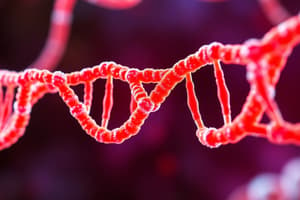Podcast
Questions and Answers
What is the difference between sister chromatids and homologous chromosomes?
What is the difference between sister chromatids and homologous chromosomes?
- Sister chromatids are produced through binary fission, while homologous chromosomes are produced through mitosis.
- Sister chromatids are the same as homologous chromosomes. There is no difference.
- Homologous chromosomes are pairs of chromosomes (one from each parent) that have the same genes but may have different alleles. They are similar in size, shape, and genetic content, and are involved in meiosis. (correct)
- Sister chromatids are identical copies of a chromosome connected by a centromere and are formed during DNA replication. They are produced during the S phase of the cell cycle and are separated during mitosis. (correct)
What are the key events that occur during each phase of the cell cycle and mitosis? (Select all that apply)
What are the key events that occur during each phase of the cell cycle and mitosis? (Select all that apply)
- Cytokinesis: The cytoplasm divides, resulting in two separate daughter cells. (correct)
- Telophase: Chromosomes decondense, nuclear envelopes reform around the two sets of chromosomes, and the mitotic spindle disassembles. (correct)
- Anaphase: Sister chromatids are pulled apart to opposite poles of the cell. (correct)
- Prophase: Chromatin condenses into visible chromosomes, the mitotic spindle forms, and the nuclear envelope breaks down. (correct)
- Metaphase: Chromosomes align at the metaphase plate, and spindle fibers attach to the centromeres of the chromosomes. (correct)
Explain the difference between haploid and diploid cells. Give an example of each.
Explain the difference between haploid and diploid cells. Give an example of each.
Haploid cells contain one set of chromosomes (n), while diploid cells contain two sets of chromosomes (2n). Haploid cells include gametes (sperm and egg cells) while diploid cells include somatic (body) cells.
What is the overall equation for cellular respiration?
What is the overall equation for cellular respiration?
What are the characteristics of living things?
What are the characteristics of living things?
What is the basic unit of life?
What is the basic unit of life?
What are the levels of biological organization, from smallest to largest?
What are the levels of biological organization, from smallest to largest?
What is the difference between discovery science and hypothesis science?
What is the difference between discovery science and hypothesis science?
A theory is a well-supported explanation that has been repeatedly tested and confirmed.
A theory is a well-supported explanation that has been repeatedly tested and confirmed.
Which of the following is NOT a type of macromolecule?
Which of the following is NOT a type of macromolecule?
What are the key differences between prokaryotes and eukaryotes?
What are the key differences between prokaryotes and eukaryotes?
What is the function of the plasma membrane?
What is the function of the plasma membrane?
What is the role of the mitochondria?
What is the role of the mitochondria?
What is the function of the chloroplast?
What is the function of the chloroplast?
What is the difference between diffusion and osmosis?
What is the difference between diffusion and osmosis?
What is the role of ATP in cellular processes?
What is the role of ATP in cellular processes?
What are the main stages of cellular respiration?
What are the main stages of cellular respiration?
What is the difference between aerobic and anaerobic respiration?
What is the difference between aerobic and anaerobic respiration?
What is the overall equation for photosynthesis?
What is the overall equation for photosynthesis?
Chlorophyll a absorbs primarily blue-violet and red light.
Chlorophyll a absorbs primarily blue-violet and red light.
What are the main products of the light-dependent reactions in photosynthesis?
What are the main products of the light-dependent reactions in photosynthesis?
What is the role of the Calvin Cycle in photosynthesis?
What is the role of the Calvin Cycle in photosynthesis?
Which type of photosynthesis is most common in plants?
Which type of photosynthesis is most common in plants?
What are the three domains of life?
What are the three domains of life?
Archaea are known for their ability to thrive in extreme environments, such as hot springs or salty lakes.
Archaea are known for their ability to thrive in extreme environments, such as hot springs or salty lakes.
What is the difference between homologous and analogous structures?
What is the difference between homologous and analogous structures?
Which of the following describes a shared derived trait?
Which of the following describes a shared derived trait?
What is the role of nodes in a phylogenetic tree?
What is the role of nodes in a phylogenetic tree?
Bacteria are characterized by having peptidoglycan in their cell walls.
Bacteria are characterized by having peptidoglycan in their cell walls.
What are some beneficial roles of bacteria in the environment?
What are some beneficial roles of bacteria in the environment?
What is the main characteristic that distinguishes protists from other eukaryotes?
What is the main characteristic that distinguishes protists from other eukaryotes?
How do fungi obtain nutrients?
How do fungi obtain nutrients?
What are the key structural features of fungi?
What are the key structural features of fungi?
Describe the ecological role of fungi as decomposers.
Describe the ecological role of fungi as decomposers.
Gametes are haploid cells, meaning they have one set of chromosomes.
Gametes are haploid cells, meaning they have one set of chromosomes.
What are the key events that occur during each phase of mitosis?
What are the key events that occur during each phase of mitosis?
What is the difference between mitosis and meiosis?
What is the difference between mitosis and meiosis?
How do independent assortment and crossing over contribute to genetic diversity in offspring during meiosis?
How do independent assortment and crossing over contribute to genetic diversity in offspring during meiosis?
What is the difference between a gene and an allele?
What is the difference between a gene and an allele?
What is the difference between a dominant allele and a recessive allele?
What is the difference between a dominant allele and a recessive allele?
What is the difference between incomplete dominance and codominance?
What is the difference between incomplete dominance and codominance?
What is the central dogma of molecular biology?
What is the central dogma of molecular biology?
What are the three main steps of transcription?
What are the three main steps of transcription?
Explain how insertion, deletion, and substitution mutations can affect organisms.
Explain how insertion, deletion, and substitution mutations can affect organisms.
Describe the characteristics of viruses and how they replicate.
Describe the characteristics of viruses and how they replicate.
What are bacteriophages?
What are bacteriophages?
What are the differences between the lytic cycle and the lysogenic cycle of bacteriophages?
What are the differences between the lytic cycle and the lysogenic cycle of bacteriophages?
How does the COVID-19 virus (SARS-CoV-2) infect humans?
How does the COVID-19 virus (SARS-CoV-2) infect humans?
What are some ways in which species are defined?
What are some ways in which species are defined?
What are the different types of selection?
What are the different types of selection?
What are the four main types of tissues in the human body?
What are the four main types of tissues in the human body?
What is homeostasis?
What is homeostasis?
What are the differences between innate and adaptive immunity?
What are the differences between innate and adaptive immunity?
What are some examples of defenses against predation and herbivory?
What are some examples of defenses against predation and herbivory?
What is the difference between population size and population density?
What is the difference between population size and population density?
What are the different types of species distribution patterns?
What are the different types of species distribution patterns?
What are density-dependent factors and density-independent factors?
What are density-dependent factors and density-independent factors?
What are some examples of interspecific interactions?
What are some examples of interspecific interactions?
Flashcards
Order (living things)
Order (living things)
Organized structures, such as cells, that make up living organisms.
Reproduction
Reproduction
The ability of living things to produce offspring.
Growth & Development
Growth & Development
Living things increase in size and complexity following a certain pattern.
Energy Processing
Energy Processing
Signup and view all the flashcards
Regulation
Regulation
Signup and view all the flashcards
Response to Environment
Response to Environment
Signup and view all the flashcards
Evolutionary Adaptation
Evolutionary Adaptation
Signup and view all the flashcards
Atom (biology)
Atom (biology)
Signup and view all the flashcards
Molecule (biology)
Molecule (biology)
Signup and view all the flashcards
Organelle
Organelle
Signup and view all the flashcards
Prokaryotic cell
Prokaryotic cell
Signup and view all the flashcards
Eukaryotic cell
Eukaryotic cell
Signup and view all the flashcards
Atomic Number
Atomic Number
Signup and view all the flashcards
Mass Number
Mass Number
Signup and view all the flashcards
Isotope
Isotope
Signup and view all the flashcards
Ion
Ion
Signup and view all the flashcards
DNA Replication
DNA Replication
Signup and view all the flashcards
Complete Dominance
Complete Dominance
Signup and view all the flashcards
Incomplete Dominance
Incomplete Dominance
Signup and view all the flashcards
Central Dogma
Central Dogma
Signup and view all the flashcards
Transcription
Transcription
Signup and view all the flashcards
Translation
Translation
Signup and view all the flashcards
Enzyme
Enzyme
Signup and view all the flashcards
What is the difference between sister chromatids and homologous chromosomes?
What is the difference between sister chromatids and homologous chromosomes?
Signup and view all the flashcards
Haploid vs. Diploid Cells
Haploid vs. Diploid Cells
Signup and view all the flashcards
Prokaryotic vs. Eukaryotic Cell Division
Prokaryotic vs. Eukaryotic Cell Division
Signup and view all the flashcards
Interphase (Cell Cycle)
Interphase (Cell Cycle)
Signup and view all the flashcards
What are the four stages of Mitosis?
What are the four stages of Mitosis?
Signup and view all the flashcards
Cytokinesis (Cell Division)
Cytokinesis (Cell Division)
Signup and view all the flashcards
Gametes vs. Somatic Cells
Gametes vs. Somatic Cells
Signup and view all the flashcards
Meiosis I: Prophase I
Meiosis I: Prophase I
Signup and view all the flashcards
Meiosis I: Metaphase I, Anaphase I & Telophase I
Meiosis I: Metaphase I, Anaphase I & Telophase I
Signup and view all the flashcards
Meiosis II: What happens?
Meiosis II: What happens?
Signup and view all the flashcards
Independent Assortment of Chromosomes
Independent Assortment of Chromosomes
Signup and view all the flashcards
Crossing Over (Meiosis)
Crossing Over (Meiosis)
Signup and view all the flashcards
Similarities and Differences: Meiosis vs. Mitosis
Similarities and Differences: Meiosis vs. Mitosis
Signup and view all the flashcards
Gene (Biology)
Gene (Biology)
Signup and view all the flashcards
Allele
Allele
Signup and view all the flashcards
Dominant vs. Recessive Alleles
Dominant vs. Recessive Alleles
Signup and view all the flashcards
Phenotype: The observable traits or characteristics of an organism.
Phenotype: The observable traits or characteristics of an organism.
Signup and view all the flashcards
Genotype: The genetic makeup of an organism, represented by alleles.
Genotype: The genetic makeup of an organism, represented by alleles.
Signup and view all the flashcards
Homozygous vs. Heterozygous
Homozygous vs. Heterozygous
Signup and view all the flashcards
What is complete dominance?
What is complete dominance?
Signup and view all the flashcards
What is Incomplete Dominance?
What is Incomplete Dominance?
Signup and view all the flashcards
What is Codominance?
What is Codominance?
Signup and view all the flashcards
What is Polygenic Inheritance?
What is Polygenic Inheritance?
Signup and view all the flashcards
What is Epistasis?
What is Epistasis?
Signup and view all the flashcards
What are Multiple Alleles?
What are Multiple Alleles?
Signup and view all the flashcards
Sex-Linked vs. Non-Sex-Linked Genes
Sex-Linked vs. Non-Sex-Linked Genes
Signup and view all the flashcards
Study Notes
Chapter 1: Introduction to Biology
- Living things exhibit several properties, including order, reproduction, growth and development, energy processing, regulation, response to the environment, and evolutionary adaptation.
- Biological organization ranges from atoms to molecules to cells to tissues to organs to organ systems to organisms to populations to communities to ecosystems to biosphere.
- Taxonomy classifies organisms hierarchically (Domain, Kingdom, Phylum, Class, Order, Family, Genus, Species).
- Discovery science involves observation, while hypothesis science involves experimentation.
- A hypothesis is a testable explanation, and a theory is a broad explanation supported by evidence.
Chapter 2: Chemistry of Life
- Atoms consist of protons (positive), neutrons (neutral), and electrons (negative).
- Atomic number is the number of protons.
- Mass number is the sum of protons and neutrons.
- Isotopes are atoms with the same number of protons but different numbers of neutrons.
- Ions are charged atoms that have gained or lost electrons.
- Electron configurations describe the arrangement of electrons in an atom's orbitals.
- Chemical bonds, like ionic and covalent bonds, hold atoms together to form molecules.
- Water is a polar molecule with cohesion, adhesion, high heat capacity, and solvent properties.
- pH measures the concentration of hydrogen ions (H+) in a solution.
- Macromolecules (carbohydrates, lipids, proteins, and nucleic acids) are essential for life.
Chapter 3: Cell Structure and Function
- Cells are the basic units of life, categorized into prokaryotic (no nucleus) and eukaryotic (with nucleus) types.
- The endosymbiotic theory explains the origin of mitochondria and chloroplasts.
- The plasma membrane regulates transport across the cell.
- Organelles serve diverse functions within cells (e.g., cytoplasm, cytoskeleton, nucleus, rough ER, smooth ER).
Chapter 4: How Cells Obtain Energy
- Cells obtain energy through cellular respiration, which converts glucose and oxygen into ATP, carbon dioxide, and water.
- Enzymes speed up reactions by lowering the activation energy.
- Inhibitors affect enzyme activity.
- ATP powers cellular work through phosphorylation.
Chapter 5: Photosynthesis
- Photosynthesis is the process by which plants convert light energy into chemical energy (glucose).
- Chlorophyll and other pigments capture light energy.
- The light-dependent reactions generate ATP and NADPH, while the Calvin cycle converts CO2 into glucose.
- C3, C4, and CAM photosynthesis are different mechanisms for carbon fixation.
Chapter 12: Diversity of Life
- Living things are categorized into domains (Bacteria, Archaea, Eukarya).
- Taxonomy uses a hierarchical system (Domain > Kingdom > Phylum > Class > Order > Family > Genus > Species) to classify organisms.
- Homologous structures share a common ancestry, while analogous structures have similar functions but different origins.
- Phylogenetic trees show evolutionary relationships among organisms.
Chapter 13: Microbes, Fungi, and Protists
- Microorganisms (bacteria, archaea, protists) exhibit diverse characteristics and play important roles in ecosystems and human health.
- Fungi are eukaryotes that obtain nutrients by absorbing organic matter.
- Protists are eukaryotes that are not animals, plants, or fungi.
Chapter 6: Reproduction at the Cellular Level
- Sister chromatids are identical copies of a chromosome.
- Homologous chromosomes are chromosome pairs from each parent.
- Haploid cells have one set of chromosomes, whereas diploid cells have two sets.
- Prokaryotes divide by binary fission, while eukaryotes divide by mitosis and meiosis.
- Meiosis produces haploid gametes, while mitosis produces diploid somatic cells.
Chapter 7: Cellular Basis of Inheritance
- Gametes are haploid reproductive cells (sperm and egg).
- Somatic cells are diploid body cells.
- Meiosis involves two rounds of cell division, producing four haploid daughter cells.
- Mitosis produces two diploid daughter cells.
Chapter 8: Patterns of Inheritance
- Genes code for traits, and alleles are different forms of a gene.
- Inheritance patterns include complete dominance, incomplete dominance, codominance, multiple alleles, polygenic inheritance, and epistasis.
- Sex-linked genes are located on sex chromosomes (X or Y) and can exhibit different inheritance patterns than autosomal genes.
Chapter 9: Molecular Biology
- DNA replicates semi-conservatively, creating identical copies of DNA.
- The central dogma describes the flow of genetic information from DNA to RNA to protein.
- Transcription is the process of making RNA from a DNA template.
- Translation is the synthesis of a polypeptide (protein) from an mRNA template.
Chapter 15: Mutations
- Mutations are changes in DNA sequence.
- Mutations can be harmful, beneficial, or neutral.
- Types of mutations include insertion, deletion, and substitution mutations.
Chapter 17: The Immune System
- Innate and adaptive immunity provide defenses against pathogens.
- Immune cells, such as phagocytes, T cells, and B cells, play vital roles in immune responses.
- Antigens trigger immune responses, and antibodies are produced to neutralize them.
Chapter 19: Population and Community Ecology
- Population size and density are key measures.
- Species distributions can be random, clumped, or uniform.
- Population growth can be exponential or logistic.
- Density-dependent and density-independent factors influence population sizes.
- Interspecific interactions (competition, predation, herbivory, commensalism, mutualism, parasitism) shape communities.
Studying That Suits You
Use AI to generate personalized quizzes and flashcards to suit your learning preferences.




